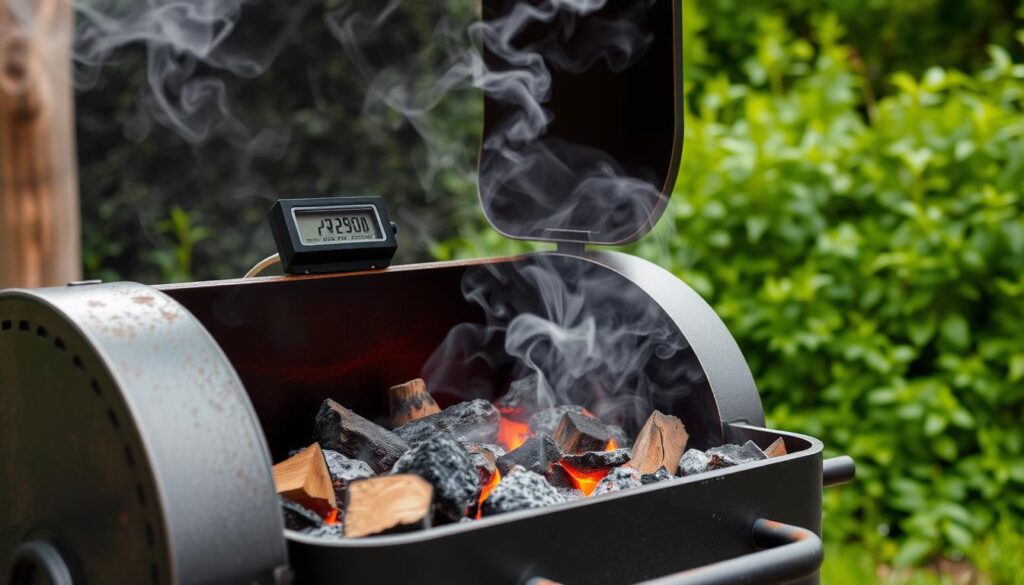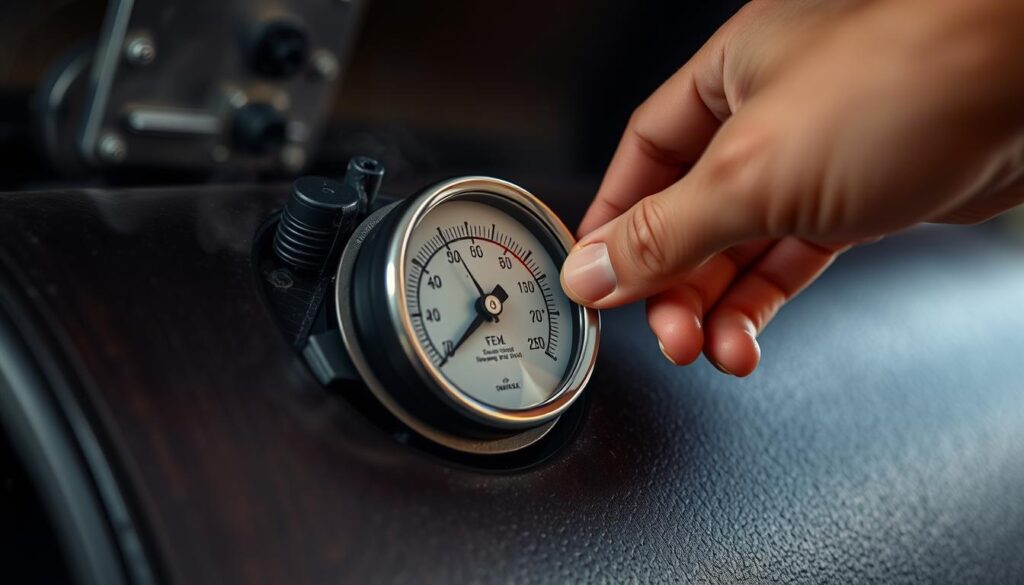How to Maintain Consistent Temperature in Your Smoker
Have you ever had a brisket that was dry and tough because of uneven heat? Keeping the right temperature while smoking is key to getting delicious, tender results every time. But how do you control the temperature in your smoker?
This guide will teach you how to manage your smoker’s temperature. You’ll learn about the factors that affect it and how to adjust vents for consistent heat. With these tips, you can make restaurant-quality smoked meats in your backyard. Get ready to wow your family and friends with amazing smoked dishes.
Key Takeaways
- Understand the importance of consistent temperature for achieving the perfect smoky flavor and texture in smoked meats.
- Learn how to control the airflow, fire intensity, and smoke consistency in your smoker to maintain the desired temperature.
- Discover the secrets to using water pans and monitoring smoker temperature accurately for optimal results.
- Explore fuel management techniques, including understanding the burning properties of different wood types, to keep your smoker at the right temperature.
- Understand the relationship between smoke color and flavor, and learn how to achieve the ideal thin, bluish smoke for maximum tastiness.
Understanding Temperature Control in Smokers
Keeping the temperature steady is key to perfect smoked meats. If the temperature changes, it can ruin the cooking. To get it right, know what affects the heat.
Importance of Consistent Temperature for Smoked Meats
For great smoked meats, consistency is key. If the temperature changes too much, some meat might cook too much or not enough. This messes with the flavor and texture.
Factors Affecting Smoker Temperature: Airflow, Fire Intensity, and Smoke Consistency
Three main things affect your smoker’s temperature: airflow, fire intensity, and smoke consistency. Getting these right helps keep the temperature steady and right.
- Airflow: Air moving through your smoker helps control the temperature. Good airflow means better combustion, which affects the heat.
- Fire Intensity: How hot the fire is in your firebox changes the heat. You need to control the fuel to keep the temperature even.
- Smoke Consistency: The smoke’s quality affects the temperature too. You want thin, blue smoke for the best flavor and temperature.
By managing these factors, you can control your smoker’s temperature. This leads to delicious, perfectly cooked smoked meats every time.
Preparing Your Smoker for Temperature Control
Before you can effectively control the temperature in your smoker, make sure it’s clean and well-kept. Start by cleaning the firebox, getting rid of any soot and grease. This boosts airflow and makes combustion better.
Cleaning and Prepping the Firebox
It’s key to clean the smoker firebox regularly for good temperature control. Here’s how to prep your firebox:
- Brush out any ash or debris, ensuring the firebox is clear of obstructions.
- Use a stiff wire brush to scrub the interior walls, removing built-up creosote and grease.
- Wipe down the firebox with a damp cloth to remove any remaining residue.
- Check the firebox for damage or wear, and fix it before your next use.
Using a Chimney Starter for Efficient Coal Ignition
Lighting your charcoal or wood is key to achieving consistent temperature in your smoker. A chimney starter makes it easier and more efficient:
- Fill the chimney starter with your preferred charcoal or wood chunks.
- Put the chimney starter on a heat-resistant surface, like a grate or fireproof mat.
- Light the fuel at the bottom of the chimney with a long match or fire starter.
- Wait for the fuel to light fully and get to the right temperature before moving it to your smoker’s firebox.
By using a chimney starter, you get a consistent and reliable fire ignition. This makes it easier to control the temperature in your smoker during cooking.
Mastering the Art of Vent Adjustment
Adjusting the intake and exhaust vents on your smoker is key to keeping temperatures steady and getting perfect smoked meats. The intake vent lets oxygen into the firebox to fuel the fire. The exhaust vent lets out hot air and gases. Finding the right balance between these vents is crucial for good combustion and temperature control.
Role of Intake and Exhaust Vents in Temperature Regulation
The intake vent controls how much oxygen gets to the fire, which affects the flames and smoker temperature. By adjusting it, you can keep the heat steady for smoking. The exhaust vent helps control the release of hot air and smoke, which also impacts the temperature. By balancing these vents, you create a stable environment for smoking, leading to consistent and tasty results.
Balancing Oxygen Flow for Optimal Combustion
- The intake vent should be open enough for efficient burning but not too much to avoid a fierce fire.
- Adjust the exhaust vent to let the right amount of hot air and smoke out, keeping the smoker at the right temperature.
- Try different vent settings to find the balance that keeps your smoked meats at the desired temperature.
Mastering vent adjustment lets you control your smoker’s temperature for consistent, tasty results every time. Remember, the smoker vent adjustment, intake vent for smokers, exhaust vent for smokers, and oxygen flow in smokers are key to temperature control and good combustion.
Maintain temperature in smoker
Keeping the perfect temperature in your smoker is key to delicious smoked meats. Whether you’re an expert or new to smoking, learning how to maintain smoker temperature is crucial. We’ll explore ways to adjust smoker temperature and troubleshoot smoker temperature issues for great results.
Using vents is a main way to keep your smoker at the right temperature. By controlling the intake and exhaust vents, you can manage airflow and temperature. Make sure the oxygen flow is right to affect the fire’s strength and the temperature.
- Adjust the intake vent to control the air going into the smoker, which changes the fire’s strength.
- Watch the exhaust vent to make sure smoke and heat leave properly, keeping the temperature steady.
- Try different vent positions to find what works best for your smoker and the meat you’re cooking.
Choosing the right fuel and adding it as needed is also important for maintaining smoker temperature. Different woods burn at different rates and produce various heat levels. Knowing about these can help you pick the best wood to keep your temperature steady.
| Wood Type | Burn Time | Heat Output |
|---|---|---|
| Hickory | Long | High |
| Oak | Medium | Medium |
| Maple | Short | Low |
It’s important to keep an eye on your vents and fuel to keep the temperature right. By getting good at this, you’ll make consistently tasty smoked meats that everyone will love.

Using Water Pans for Temperature Stabilization
Keeping a steady temperature is key to smoking meats right. Using water pans helps with this. They create an even heat by acting as an indirect heat source. This stops hot spots and keeps the meat cooking evenly.
When water in the pan evaporates, it also keeps the smoker’s humidity steady. This moisture is great for keeping smoked meats juicy and tender. Water pans for smokers work like a heat sink, slowly releasing heat to keep the temperature steady.
Put the water pan right under your meat for best results. This lets the indirect heat in smokers cook your food gently from below. Check the water often and add more as needed to keep the temperature steady.
“Using a water pan is one of the best ways to achieve that elusive balance of smoke, heat, and moisture in your smoker.”
Try different water levels and positions to find what works best for your smoker and taste. Learning how to use water pans can take your smoked meats to the next level of flavor and tenderness.
Monitoring Smoker Temperature Accurately
Keeping the temperature steady is crucial for delicious smoked meats. Many smokers have thermometers built in, but they might not be precise enough. By following a few simple steps, you can make sure your smoker’s temperature is spot on. This lets you adjust things as needed and keep your food perfect.
Calibrating Built-in Thermometers
To get accurate temperature readings, start by calibrating your smoker’s thermometer. These thermometers can lose their accuracy over time. Calibrating them is easy:
- Boil water and put the thermometer in, making sure it doesn’t touch the pot’s bottom.
- Wait for the temperature to settle, then check the reading. At sea level, water boils at 212°F (100°C).
- If the reading is off, adjust the thermometer as the maker suggests to get it right.
Using Dedicated Thermometer Probes for Precise Readings
Calibrating your built-in thermometer is a good first step. But for the most accurate readings, use dedicated thermometer probes. These tools can be placed in your smoker to give you detailed temperature info. This lets you adjust the heat to keep your food just right.
| Thermometer Type | Accuracy | Ease of Use | Portability |
|---|---|---|---|
| Built-in Smoker Thermometer | Moderate | High | Low |
| Dedicated Thermometer Probe | High | Moderate | High |
Using a calibrated built-in thermometer and dedicated probes will help you master smoker thermometer calibration and accurate temperature monitoring in smokers. This combo is essential for consistently tasty smoked meats.

Fuel Management for Temperature Control
Keeping a steady temperature in your smoker is key for perfect flavor and texture in smoked meats. The type and amount of fuel you use play a big role in controlling the temperature. Different wood types for smokers and charcoal types burn at different rates and temperatures. Knowing how they burn is important for managing fuel in smokers.
Understanding the Burning Properties of Different Wood Types
Each wood type has its own burning traits that can change the temperature and flavor of your smoked meats. Here’s a quick look at some popular woods and their burning traits:
- Hickory – Makes a strong, bold smoke flavor and burns hot and steady.
- Mesquite – Burns very hot and gives a unique, slightly sweet flavor.
- Oak – Gives a mild, classic smoke flavor and burns at a medium temperature.
- Maple – Offers a subtle, sweet smoke and burns at a relatively low temperature.
Replenishing Fuel for Long Smoking Sessions
For longer smoking times, you’ll need to add fuel to your smoker to keep the temperature right and the fire strong. This might mean adding more charcoal, wood chunks, or a mix of both, based on your smoker. Always check the fire and fuel levels and add more as needed for a steady smoke.
“Mastering fuel management is key to perfect temperature and flavor in smoked meats. Try different wood types and charcoal to find the best mix for your smoker and taste.”
Smoke Color: The Key to Flavorful Smoking
The color of smoke from your smoker is key to tasty smoked meats. Many think more smoke means more flavor, but that’s not true. Thick, white smoke can make your meat taste bitter. Aim for a thin, bluish smoke for a delicate flavor.
Understanding the Relationship Between Smoke Color and Flavor
The smoke color tells you a lot about your meat’s flavor. Smoke color in smokers shows the quality of the smoke. Thin, bluish smoke means a clean burn, giving a mild, refined smoke flavor in smokers.
On the other hand, thick, white smoke means the burn is not complete. This can make your meat taste harsh and overpowering.
Techniques for Achieving Thin, Bluish Smoke
- Start with high-quality, well-seasoned wood chips or chunks that are free of moisture.
- Use a chimney starter to efficiently ignite your charcoal or wood, ensuring a clean, consistent burn.
- Carefully manage the airflow in your smoker by adjusting the intake and exhaust vents to maintain the ideal oxygen-to-fuel ratio.
- Replenish your fuel source as needed, keeping a steady, even temperature throughout the smoking process.
- Experiment with different wood varieties to find the perfect balance of achieving thin blue smoke in smokers and complementary flavor profiles.
By understanding smoke color and flavor, and using the right techniques, you can make smoked meats full of delicious flavors.
Conclusion
Keeping your smoker at a steady temperature is key to making delicious, flavorful meats. You need to know how things like airflow and fuel affect the temperature. By learning how to manage these, you can control the temperature in your smoker.
Using the right techniques helps a lot. This includes managing vents, using water pans, and checking your thermometers. These steps help you get the perfect temperature and smoke for your food.
As you get better at controlling your smoker’s temperature, your smoked meats will get better. You’ll make everything from tender briskets to juicy ribs perfectly. Just follow the advice in this article to improve your BBQ skills.
Learning to control the temperature takes time and practice. Be patient and keep trying new things. With effort, you’ll get great at it. Soon, you’ll be making smoked dishes that everyone will love.

Leave a Reply